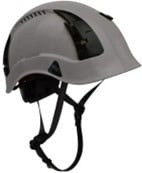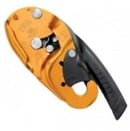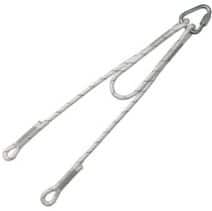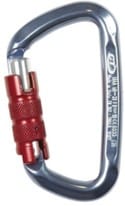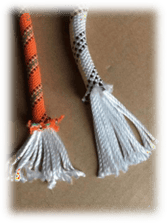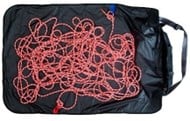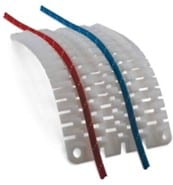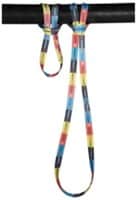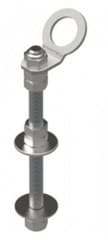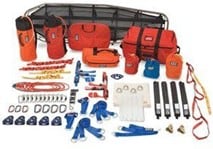2.0 Section 2: The Fundamentals.
Rope access is a highly specialized method of working at height that allows technicians to safely reach and perform tasks on vertical surfaces using a system of ropes and harnesses. While it offers unmatched flexibility and efficiency in high-rise environments, it also demands strict adherence to safety protocols, system design, and redundancy. Before technicians can work on a façade, they must first understand how rope access systems are built, how they differ from traditional fall protection, and what components are essential for safe, controlled vertical movement. This section lays the groundwork for everything that follows—because mastering the fundamentals is critical not only for performance, but for survival.
2.1 Rope Access Systems: The Two-Rope Method
Rope access relies on a system of two independent, load-bearing ropes — a method designed to ensure that if one rope fails, the second will prevent a catastrophic fall. This is a global best practice and is required under IRATA, SPRAT, CSA, and most employer policies.
Main (Working) Line
- Supports the technician during descent, ascent, or positioning
- Connected via a descender for control (e.g., Petzl ID, D4, Rig)
- May be equipped with positioning lanyards or work seats
Backup (Safety) Line
- Acts as secondary fall arrest
- Connected to a backup device (e.g., ASAP, Goblin, mobile fall arrester)
- Must remain independent, with separate anchorage and connection points
Key Principle: A worker must always be supported by two lines, even when transitioning between systems (e.g., rope-to-rope transfers or re-anchoring).
2.2 Rope Access vs. Traditional Fall Protection
Though both are fall protection systems under OHSA, rope access is more dynamic, versatile, and complex.
|
Comparison Point |
Traditional Fall Protection (WAH) |
Rope Access |
|
Typical Use |
Roofing, construction, ladder safety |
Window cleaning, inspection, façade repair |
|
System Type |
Lanyard or SRL with single anchor |
Two-rope system (main + backup) |
|
Anchor Use |
Shared or static anchor |
Two independent anchor points |
|
Movement |
Limited or static |
Full 3D movement and work positioning |
|
Redundancy |
Minimal |
Full system redundancy |
|
Supervision |
General foreman or safety rep |
Requires experienced oversight |
Important: Many high-rise employers may still refer to “fall protection,” but rope access is a specialized subset with its own gear, methods, and training levels.
2.3 Key Components of a Rope Access System
Proper function of a rope access system depends on the interrelation of specialized components:
|
Equipment |
Description |
Image |
|
Full-Body Harness |
Designed to distribute fall forces across thighs, pelvis, chest, and shoulders. Includes multiple attachment points. Must meet CSA Z259.10. |
|
|
Helmet with Chin Strap |
Protective headgear rated for industrial use with side/back protection and a secure chin strap. |
|
|
Descender |
Device (e.g., Petzl ID, Rig) that controls descent speed and allows for hands-free positioning. |
|
|
Equipment |
Description |
Image |
|
Ascender |
Rope-gripping device that moves upward but locks when downward force is applied. |
|
|
Backup Device |
Device like ASAP or Duck that follows the user and locks in the event of a fall. |
|
|
Cow’s Tail/Lanyard |
Short rope or webbing used for connection or positioning. It can include shock absorption. |
|
|
Equipment |
Description |
Image |
|
Locking Carabiners |
Steel/aluminum connectors with manual or auto-locking gates. Used to join equipment safely. |
|
|
Static Rope |
Low-stretch kernmantle rope designed for load-bearing and controlled descent. CSA Z259.2.5. |
|
|
Rope Bag |
Protects rope from UV, contamination, and abrasion. Also used for transporting gear. |
|
|
Equipment |
Description |
Image |
|
Edge Protection |
Padding or plastic covers to prevent rope damage from sharp edges or rough surfaces. |
|
|
Anchor Slings |
Webbing or rope used to create temporary anchor points around structural features. |
|
|
Anchors |
An anchor that can support all loads applied. It can be temporary or permanently imbedded in the structure. |
|
|
Equipment |
Description |
Image |
|
Rescue Kit |
Pre-assembled gear for pick-off or haul rescue operations. Must be accessible on site. |
|
2.4 Best Practices s System Redundancy
- Avoid shared anchors — one rope, one anchor
- Ensure that the backup rope stays tensioned but not loaded
- Always use rope end knots or stoppers to prevent accidental descent off the end
- Regularly inspect and log every component before use
- Use backups for tools, helmets, and even anchor slings




